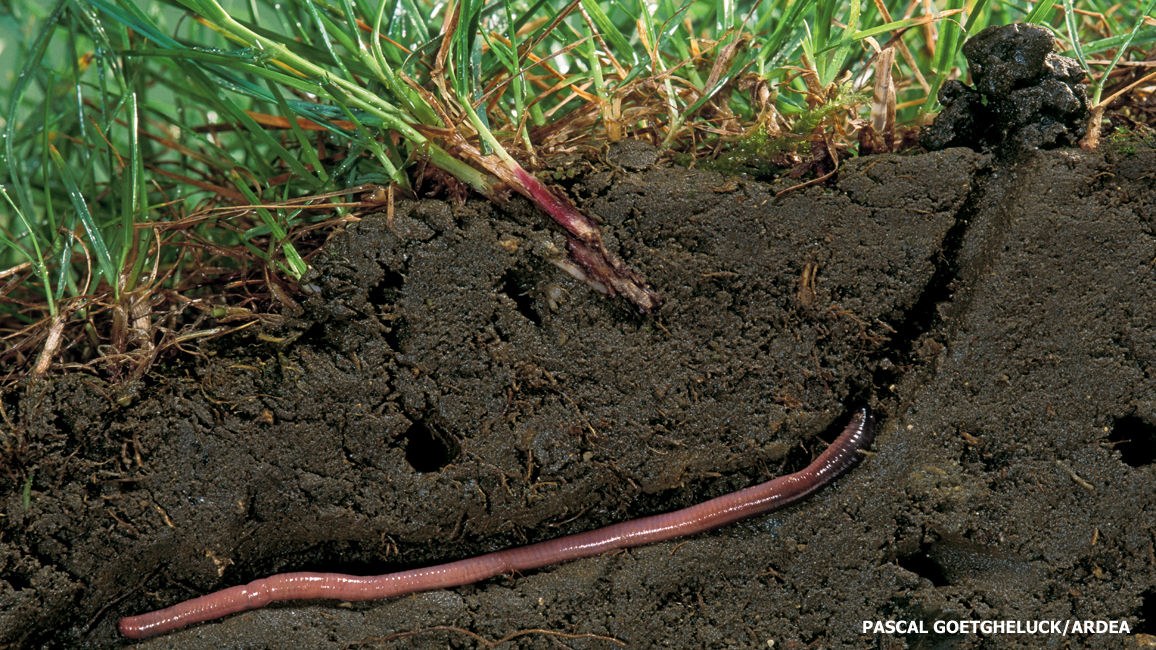
Earthworms
By Kate HofmannThey’re slimy, squirmy, and found underground. Dig in and see what they’re up to down in the dirt!

All over the world, earthworms are underfoot. They’re munching on leaves and traveling through tunnels like the one above. There are thousands of earthworm species. The tiniest can hardly be seen, and the biggest may grow to be 10 feet long. But they all do huge amounts of work for their size. More on that soon. First, just how does an earthworm get around with no legs?
It has two different sets of muscles—one set scrunches up the body, and the other stretches it out. By becoming short, then long, then short again, a worm inches through the soil. A worm’s body is made up of many little ring-like segments. (See diagram.) Each segment has tiny, bristly hooks called setae (SEE-tee). The setae grip the sides of the tunnel as the worm moves itself along.
Every earthworm has both male and female parts. But a worm still has to mate with another worm to have babies. That’s when the worm uses the thick band around its body called the clitellum (klye-TEL-um). After the worms mate, each one’s clitellum forms a tube of mucus that holds the eggs. The worms slide out of the tubes and leave them behind. The ends close up, and the tubes harden into cocoons. Later, one or more tiny baby worms will emerge from each cocoon.
VIDEO: WATCH VERY BUSY EARTHWORMS IN COMPOST WASTE

Worms at Work
Earthworms are nature’s recyclers. Some kinds live in the leaf layer above the soil surface. Others live deeper in the soil. No matter where they live, they eat dead stuff. Worms munch bits of dead plants and animals, and they eat soil full of even smaller bits of the same things.
First the food gets ground up in the worm’s gizzard, a tube of muscle with grit inside. Then it moves down the worm’s long, narrow gut. Whatever the worm’s body doesn’t use comes out the back end as castings. These castings are full of food that helps plants grow.
Worms are also nature’s engineers. Like a construction crew, they move dirt around. They pull dead material down from the surface and bring minerals up from below. They break up clods. Their tunnels add air to the soil and help rainwater soak into the ground.
Catching Worms
Earthworms can’t just do all this work in peace, though. Birds, snakes, frogs, toads, salamanders, and other animals gobble them up at the surface. Moles eat them underground.
Even people like to catch them! If you fish, you might collect worms for bait. And some people take part in a sport called “worm charming.” Teams compete to get the most worms to come to the
surface. They vibrate the soil with special devices, pat it or stomp on it, and even play music. Why does it work? Maybe because the vibrations are similar to the ones made by moles. The worried worms come up to avoid being eaten.

Earthworms: Good or Bad?
Everybody knows earthworms are helpful. Gardeners love worms for making loose, rich soil. But the same things that make them good for gardens can make them bad for forests. Healthy northern forests have a deep layer of dead leaves on the ground. This provides a home for many small creatures and gives seeds a place to sprout. When worms gobble up this layer, forests suffer.
In the northern part of the United States, native earthworms disappeared more than 10,000 years ago. They were frozen out by Ice Age glaciers. The ones that live there now were all brought from other places!
Scientists are working to learn how worms are moving into forests where they haven’t been before. Keeping them out will help keep these forests healthy.
















